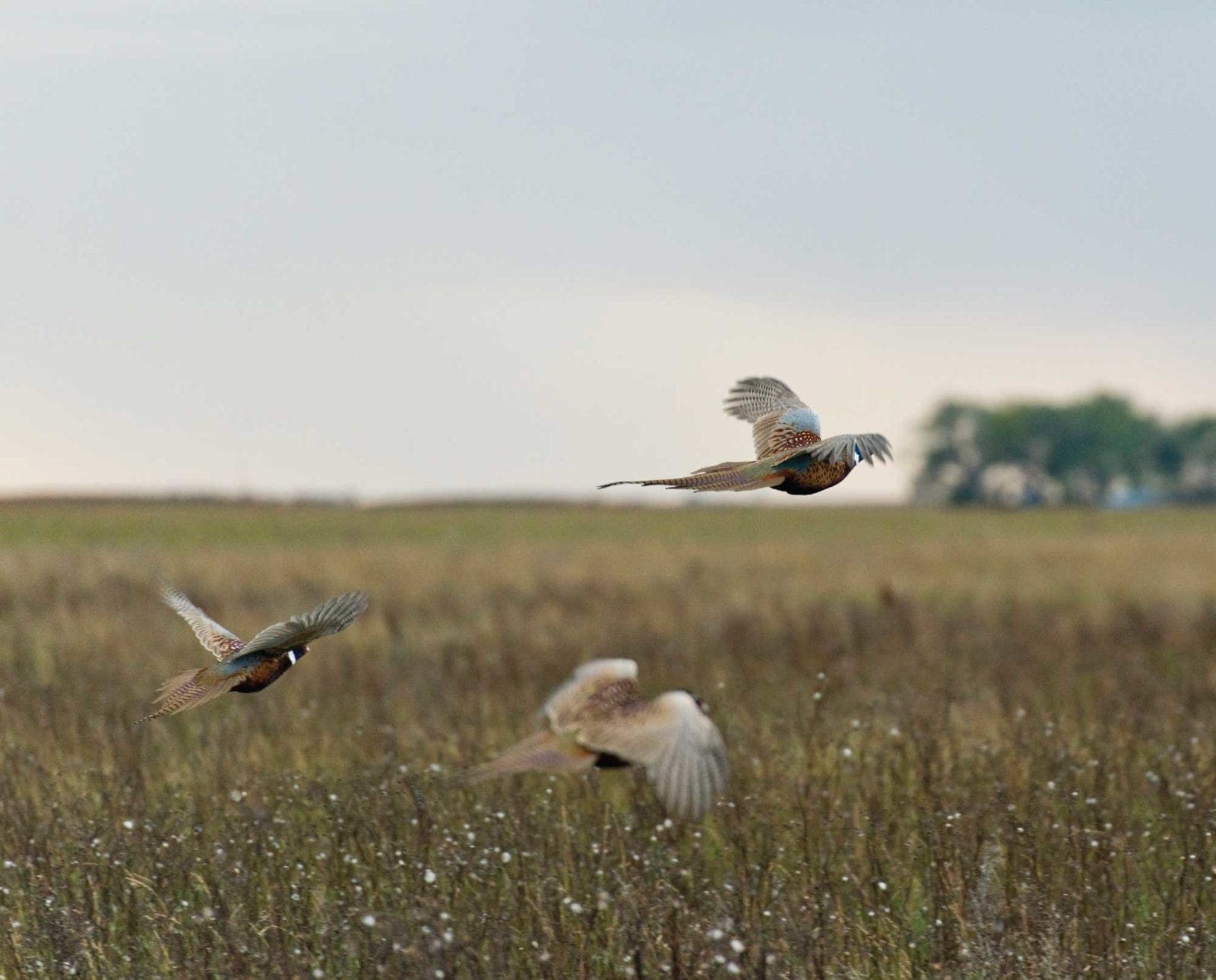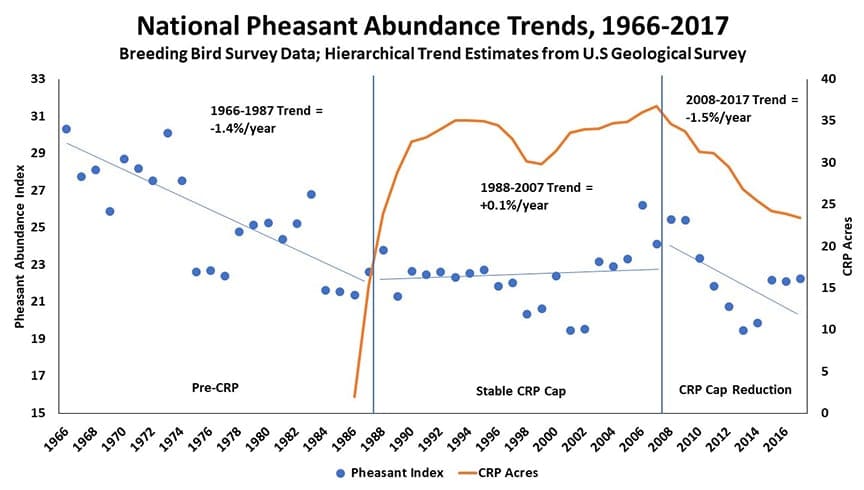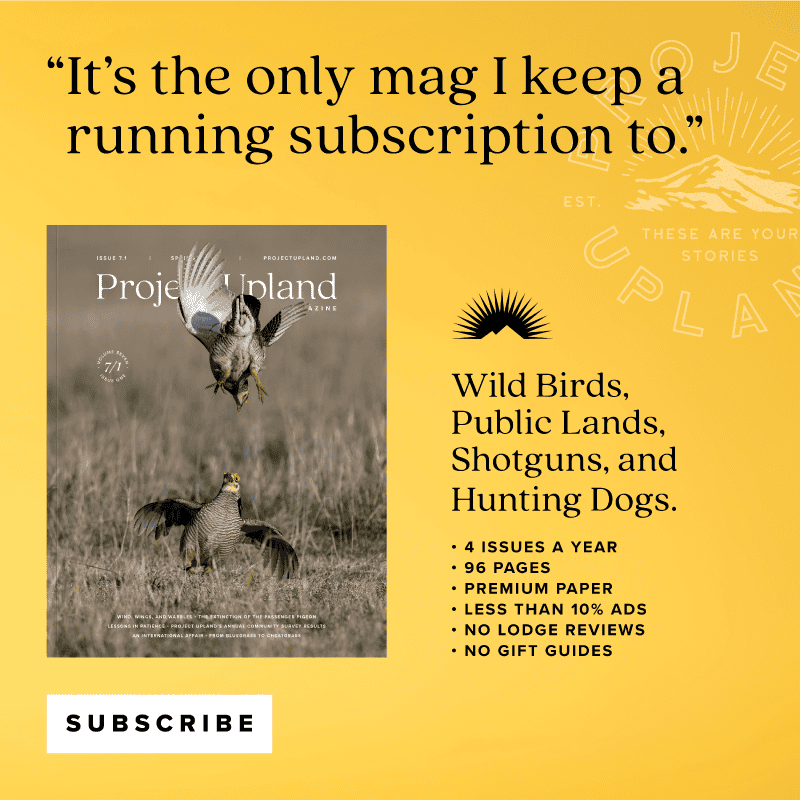Home » Conservation » Expansion of CRP Will Support Upland Bird Populations Through Habitat
Expansion of CRP Will Support Upland Bird Populations Through Habitat

Andrew Spellman is an award-winning photojournalist and author. A 2017…
Agriculture Secretary Vilsack announces program increases capacity by 4M acres to increase carbon sequestration, benefit wildlife
WASHINGTON, D.C.– A staple of American conversation is likely to see a resurgence in the early years of Joe Biden’s Administration, as U.S. Department of Agriculture Secretary Tom Vilsack announced on April 21 changes to the Conservation Reserve Program (CRP).
Following incentive rate cuts and lowered payment rates during the Trump Administration, the USDA re-opened CRP enrollment in the early days of the new administration’s term. It came at a time when CRP enrollment was at an all-time low since 2007, resting at 20.8 million acres. With the cap currently set at 25 million acres, one of the lowest in the same timeframe as enrollment declines, the USDA will gradually increase the ceiling to 27 million acres by 2023, when the new Farm Bill will be due.
“We want to make sure CRP continues to be a valuable and effective conservation resource for our producers for decades to come,” Vilsack said in a release by the USDA. “USDA will continue to find new and creative ways of putting producers and landowners at the center of climate-smart practices that generate revenue and benefit our planet.”
What is CRP and why does it affect upland birds?
The Conservation Reserve Program was created in 1985 as part of the Food Security Act and signed into law by President Ronald Reagan. The goal was to enroll farmers, ranchers, and other private landowners into a program that paid them to protect pieces of their land in exchange for cash in the form of a yearly payment. Essentially, the Federal government would rent the individuals land and pay them competitively according to commodity prices. It was reauthorized in 2018 as the Agriculture Improvement Act—more colloquially known as the 2018 Farm Bill—and from then until President Joe Biden’s inauguration had seen reductions and changes to payment rates and incentives.
The catch of CRP was that landowners would sign a 10-15 year contract, making sure the land set aside for conservation needs did its job by “re-establishing land cover to help improve water quality, prevent soil erosion, and reduce loss of wildlife habitat.”
Though a slow start, these goals were met, and by 2007 the program saw an all-time high enrollment at 38 million acres. Upland birds and other species were responding well, as many Midwestern and Western state figures show phenomenal harvests.
But, since then, changes at the federal level, weather events such as a significant drought in 2012, and loss of interest in the program due to bureaucratic blunders have led to the current historical low. Upland bird numbers have dropped, too, along with CRP enrollment, supported by data from multiple sources.

The importance of the new changes
Jared Wiklund, public relations manager for Pheasants Forever and Quail Forever, noted that raising rental rates and including new incentives will raise interest just with simple economic benefits.
“Number one, anytime you raise the rental rates and help make them a little bit more competitive to county averages, you get a lot more interest off the bat,” Wiklund said. “CRP has always served a couple of different functions: it’s soil health, it has helped prevent erosion, it has been for wildlife habitat, but it has also always sort of been a safety net to help rural communities. That’s one of the biggest things, not only do they up the rates for the Conservation Reserve Program but there are new incentives that were included with that. It’s a more targeted approach and it’s all based in the program’s role in climate resiliency. They came out and said that they’re dumping more money into it to promote the new administration’s fight for climate resiliency and we think it’s a smart move. That program is there. It’s always had some great results not just for landowners and soil but for wildlife as well.
“The big message we put forward is that landowners can let voluntary conservation programs help fill the void on their less productive acres on the farm. Even with what commodity crops are at right now, which is pretty high prices—we’re getting back to what we saw between 2008 and 2012, just some really high crop prices—at the same time there’s still saline soils and places that are flooding out that are much more suited for a voluntary conservation program. But whether that’s CRP or anything that falls under the USDA’s Farm Bill, there’s a lot of options out there for landowners to help them not only do great things for wildlife and protect the soil but also turn their red acres green by enrolling in a voluntary opportunity.”
As noted, increasing the capacity by 4 million acres is a big move to bring more landowners on board, especially through Continuous CRP, which allows landowners to sign contracts on a rolling basis, though they are still in increments of 10-15 years. The USDA reports that the 20-plus million acres currently enrolled sequester over 12 million metric tons of carbon dioxide equivalent from the atmosphere, and, if the department reaches its goal, it could raise that to 15 million CO2e while also preventing 90 million pounds of nitrogen and 33 million tons of sediment runoff. And, because CRP deals a significant amount in grassland habitat, should a wildfire break out, the carbon won’t be released back into the atmosphere since it is stored in the root systems.
Aside from raising the cap over the next two years, the USDA will also invest $330 million into 85 Regional Conservation Partnership Programs (RCPP) projects and $25 million for “On-Farm Conservation Innovation Trials.” The Farm Service Agency (FSA)—the entity overseeing CRP—is also unrolling a new, annual “Climate-Smart Practice Incentive” for both the general and continuous signups. This will look to boost sequestration and other goals by establishing trees and permanent grasses, developing wildlife habitat, and restoring wetlands, according to USDA.
“We were encouraged because of the grassland habitat that’s going to be created by CRP, and it can be a massive component of the recipe for climate resiliency,” Wiklund said. “It’s an existing program. We were once up near 40 million acres and when you go back in time—it wasn’t long ago—we had some of the highest upland bird numbers in recent history. That connection between more acres for wildlife and upland birds is there
“I think people have known what was wrong with the program for a while when they dropped rental payments to 80 percent of county averages and that particular level wasn’t getting it done for landowners that were interested. We’ve been hounding the administration for a long time and Secretary Vilsack, the announcement he made a couple of weeks ago, delivered upon every single request, basically improvement, that we’ve made since returning to USDA leadership. We were thrilled with that.”
Further, specific updates to rentals rates and incentives include: adjusting soil rental rates, increase payments for Practice Incentives from 20 percent to 50 percent, increase payments for water quality practices, and establish a CRP grassland minimum rental rate.
All of these changes are important in conjunction with the Biden Administration’s 30 by 30 plan to conserve 30 percent of the nation’s land by 2030, now given more of a spine following the release of the ‘America the Beautiful’ report on May 6. Still, tensions in some parts of the country rise when plans of the Federal government interfering with different lands are released, especially in the west.
Concerns of a land grab, expanding CRP in 2023, and PF/QF in RCPP
While concerns have risen and misinformation is being spread about the Administration’s report and the expansion of CRP, the objective truth is that this is not a land grab.
The ambiguity of the report does hurt it some in this case, but Wiklund quickly cited Principle 6: ‘Honor Private Property Rights and Support the Voluntary Stewardship Efforts off Private Landowners and Fishers.’
“People need to realize whether it’s ‘America the Beautiful’ or the 30 by 30 initiative—which is basically wrapped up into one—there’s no land grab here,” Wiklund said. “They’re coming up with voluntary enrollment options, voluntary incentives for landowners if they want to take part. We’ve said all along: we don’t want to be burdensome to landowners, farmers, ranchers. Anything that comes through related to conservation programs and climate resiliency, we need to make sure that we’re incentivizing landowners to do wonderful things for wildlife and soil health. As part of that, CRP and the Farm Bill overall—I don’t want to just focus on CRP because the Farm Bill has a lot of great conservation programs in it—there are wonderful things that can be done for wildlife.
“From our perspective, it’s great to see they’re offering a suite of—’voluntary’ is the big word here—voluntary conservation options that landowners can either take part in or not take part in.”
And, to make sure conservation programs such as CRP are successful, the Biden Administration will rely on science to lead the way, noted in Principle 7 of the ‘America the Beautiful’ plan.
As for the future Farm Bill slated to be discussed and voted on by Congress in 2023, Wiklund can see the CRP cap being expanded further in that, should the current expansion be successful.
This is something Pheasants and Quail Forever has publicly called for. In 2020, the nonprofit released a report about the future of CRP that cited a marker bill by then-Rep. Collin Peterson (D-Minn.) that would raise the enrollment capacity to 50 million acres, a point Wiklund noted PF “would love to see.”
“As part of ‘America the Beautiful’ and 30 by 30, if we’re going hit the goals the administration has laid out, we need to continually expand CRP,” Wiklund said. “Pheasants Forever/Quail Forever and a lot of our different partners all along the way have said we need a minimum of 40 million acres and probably more than that. The administration had suggested 50 million acres not that long ago. We’d love to see it get up to that point. If we can put a lot of those acres into grasslands or perennial vegetation of some sort, it’s the best carbon sink that we have in this nation, and we’d be getting all the byproducts of grasslands which is clean water, lots of pheasants, lots of upland birds, songbirds, all those things.”
It’s important to note that, along with CRP fluctuations, hunter numbers also change. Data provided by Wiklund shows a direct line in increases and decreases of CRP acreage with increases and deceases in hunter participation, respectively.

PF/QF and RCPP projects
To continue to do its part for grassland restoration and enhancement, PF/QF will receive—and has received—funding for RCPP projects.
The organization recently released a report noting that it and 12 of its partners were awarded $6.4 million by the USDA to begin the Big Game Habitat Improvement Project in north-central Montana. The project is matched dollar-for-dollar through partner contributions and, according to PF, will focus on outreach and technical/financial assistance programs to farmers and ranchers for improving grazing operations, restoring grassland habitat, and retaining intact range lands on 60,000 acres in one of the state’s most coveted big game migration corridors.
Though focused on big game, Wiklund notes the ancillary benefits for upland birds like sharp-tailed grouse, Hungarian partridge, and pheasants.
Wiklund listed other projects Pheasants Forever and Quail Forever is involved as:
- Kansas NAWCA Wetland Easements
- Missouri Monarch RCPP
- Northern Great Plains Grassland Conservation (MT)
- Grasslands Biodiversity RCPP (TN)
- Grasslands Biodiversity RCPP (KY)
- Monarch RCPP (IL, IN, IA, MN, MO, OK, TX, WI)
A bright future for CRP
All in all, Wiklund wanted to highlight what the future of the Conservation Reserve Program could be by diving into the data of its successes up to this point.
“As it relates to climate, CRP the program has sequestered on average an annual average of 49 million tons of greenhouse gases. That’s the equivalent of taking 9 million cars off the road,” Wiklund said. “Increases to that program or grasslands in general, you’re doing good things for climate resiliency while impacted all those other things Pheasants Forever and sportsmen and women care about.”
He also squashed the notion that CRP doesn’t impact pheasant populations, citing the data PF/QF collected (provided above).
“Something upland hunters need to keep in mind, there are some critics out there … that say, ‘CRP’s not the answer, it doesn’t impact pheasant populations.’ I can tell you that it does with some pretty simple graphs,” he said. “As it relates to voluntary public access and habitat incentives or just access programs in general when we have more CRP on the landscape, that’s providing more public access to private lands across the board. States like Minnesota, South Dakota, Kansas, Iowa, Nebraska, Montana to some degree…the more CRP lands we have, the more we’re going to see people enrolling property in access programs because a lot of those programs are based on grassland acres.”
Andrew Spellman is an award-winning photojournalist and author. A 2017 graduate of West Virginia University's Reed College of Media, Andrew's work has appeared in multiple newspapers and magazines. He is also an avid hunter and angler who enjoys chasing varying game in his pocket of Appalachia.




